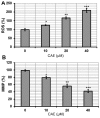Anticancer activity of caffeic acid n‑butyl ester against A431 skin carcinoma cell line occurs via induction of apoptosis and inhibition of the mTOR/PI3K/AKT signaling pathway
- PMID: 29436638
- PMCID: PMC5866006
- DOI: 10.3892/mmr.2018.8599
Anticancer activity of caffeic acid n‑butyl ester against A431 skin carcinoma cell line occurs via induction of apoptosis and inhibition of the mTOR/PI3K/AKT signaling pathway
Retraction in
-
[Retracted] Anticancer activity of caffeic acid n‑butyl ester against A431 skin carcinoma cell line occurs via induction of apoptosis and inhibition of the mTOR/PI3K/AKT signaling pathway.Mol Med Rep. 2021 May;23(5):372. doi: 10.3892/mmr.2021.12011. Epub 2021 Mar 24. Mol Med Rep. 2021. PMID: 33760142 Free PMC article.
Abstract
Skin cancer is one of the primary causes of mortality worldwide. With an increasing frequency of skin cancers, there is an urgent requirement for the development of numerous treatment options. The present study investigated the anticancer activity of caffeic acid n‑butyl ester (CAE) against the A431 skin cancer cell line. Antiproliferative effects were investigated using an MMT assay. Apoptosis was examined by DAPI and Annexin V/fluorescein isothiocyanate and propidium iodide staining. Reactive oxygen species (ROS), mitochondrial membrane potential (MMP) and cell cycle analyses were performed via flow cytometry. Protein expression was determined by western blotting. The findings of the present study demonstrated that among a variety of cancer cell lines, CAE exhibited significant anticancer activity against the A431 skin cancer cell line with a half‑maximal inhibitory concentration of 20 µM. CAE was associated with apoptosis and cell cycle arrest of A431 cells, and induced ROS‑mediated alterations in MMP. In addition, CAE considerably suppressed the expression of some of the important proteins of the phosphoinositide 3‑kinase (PI3K)/protein kinase B (AKT)/mechanistic target of rapamycin (mTOR) cascade. The results of the present study indicated that CAE exerted anticancer effects on the A431 skin carcinoma cell line via the induction of apoptosis and suppression of the PI3K/AKT/mTOR signaling pathway. Therefore, CAE may be beneficial for the development of chemotherapy for skin cancers.
Figures








Similar articles
-
Anticancer activity of ursolic acid on human ovarian cancer cells via ROS and MMP mediated apoptosis, cell cycle arrest and downregulation of PI3K/AKT pathway.J BUON. 2020 Mar-Apr;25(2):750-756. J BUON. 2020. PMID: 32521863
-
Anticancer activity of safranal against colon carcinoma is due to induction of apoptosis and G2/M cell cycle arrest mediated by suppression of mTOR/PI3K/Akt pathway.J BUON. 2018 May-Jun;23(3):574-578. J BUON. 2018. PMID: 30003721
-
Arglabin is a plant sesquiterpene lactone that exerts potent anticancer effects on human oral squamous cancer cells via mitochondrial apoptosis and downregulation of the mTOR/PI3K/Akt signaling pathway to inhibit tumor growth in vivo.J BUON. 2018 Nov-Dec;23(6):1679-1685. J BUON. 2018. PMID: 30610794
-
Promising Anticancer Activities of Alismatis rhizome and Its Triterpenes via p38 and PI3K/Akt/mTOR Signaling Pathways.Nutrients. 2021 Jul 18;13(7):2455. doi: 10.3390/nu13072455. Nutrients. 2021. PMID: 34371964 Free PMC article. Review.
-
Exploiting new strategies in combating head and neck carcinoma: A comprehensive review on phytochemical approaches passing through PI3K/Akt/mTOR signaling pathway.Phytother Res. 2024 Jul;38(7):3736-3762. doi: 10.1002/ptr.8228. Epub 2024 May 22. Phytother Res. 2024. PMID: 38776136 Review.
Cited by
-
Regenerative Wound Dressings for Skin Cancer.Cancers (Basel). 2020 Oct 13;12(10):2954. doi: 10.3390/cancers12102954. Cancers (Basel). 2020. PMID: 33066077 Free PMC article. Review.
-
Alternative Options for Skin Cancer Therapy via Regulation of AKT and Related Signaling Pathways.Int J Mol Sci. 2020 Sep 18;21(18):6869. doi: 10.3390/ijms21186869. Int J Mol Sci. 2020. PMID: 32962182 Free PMC article. Review.
-
Phenolic Compounds from Wild Plant and In Vitro Cultures of Ageratina pichichensis and Evaluation of Their Antioxidant Activity.Plants (Basel). 2023 Mar 1;12(5):1107. doi: 10.3390/plants12051107. Plants (Basel). 2023. PMID: 36903964 Free PMC article.
-
The Synthetic Flavonoid Derivative GL-V9 Induces Apoptosis and Autophagy in Cutaneous Squamous Cell Carcinoma via Suppressing AKT-Regulated HK2 and mTOR Signals.Molecules. 2020 Oct 30;25(21):5033. doi: 10.3390/molecules25215033. Molecules. 2020. PMID: 33143000 Free PMC article.
-
Role of PI3K/AKT pathway in squamous cell carcinoma with an especial focus on head and neck cancers.Cancer Cell Int. 2022 Aug 13;22(1):254. doi: 10.1186/s12935-022-02676-x. Cancer Cell Int. 2022. PMID: 35964082 Free PMC article. Review.
References
Publication types
MeSH terms
Substances
LinkOut - more resources
Full Text Sources
Other Literature Sources
Miscellaneous

